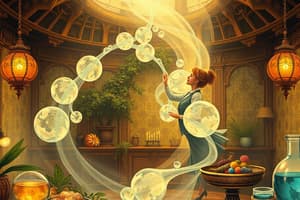Podcast
Questions and Answers
What type of change is the souring of milk?
What type of change is the souring of milk?
- Neither
- Both
- Physical Change
- Chemical Change (correct)
What type of change is crushing an aluminum can?
What type of change is crushing an aluminum can?
- Neither
- Chemical Change
- Physical Change (correct)
- Both
What type of change is cutting hair?
What type of change is cutting hair?
- Physical Change (correct)
- Neither
- Chemical Change
- Both
What type of change is rusting iron?
What type of change is rusting iron?
What type of change is burning of wood?
What type of change is burning of wood?
What type of change is breaking a cracker?
What type of change is breaking a cracker?
What type of change is baking a cake?
What type of change is baking a cake?
What type of change is grinding chalk into powder?
What type of change is grinding chalk into powder?
What type of change is dissolving sugar in water?
What type of change is dissolving sugar in water?
What type of change is tearing a piece of paper?
What type of change is tearing a piece of paper?
What type of change is stretching copper into wire?
What type of change is stretching copper into wire?
What type of change is burning gasoline?
What type of change is burning gasoline?
What type of change is hammering gold into foil?
What type of change is hammering gold into foil?
What type of change is melting ice?
What type of change is melting ice?
What type of change is digesting food?
What type of change is digesting food?
What type of change occurs with steel wool and a battery?
What type of change occurs with steel wool and a battery?
What are characteristics observed when a substance reacts or changes to produce new substances?
What are characteristics observed when a substance reacts or changes to produce new substances?
What can be measured or observed without changing the substance into a different substance?
What can be measured or observed without changing the substance into a different substance?
What is evidence of chemical change that involves a precipitate?
What is evidence of chemical change that involves a precipitate?
What is another evidence of chemical change that involves production of heat or light?
What is another evidence of chemical change that involves production of heat or light?
What is an evidence of chemical change that involves production of gas?
What is an evidence of chemical change that involves production of gas?
What is an evidence of chemical change that involves odor?
What is an evidence of chemical change that involves odor?
Flashcards are hidden until you start studying
Study Notes
Physical Change vs. Chemical Change
- Souring of milk: Represents a chemical change due to the formation of new substances.
- Crushing an aluminum can: An example of a physical change; the can's shape is altered but not its composition.
- Cutting hair: A physical change; hair retains its chemical structure even when cut.
- Rusting iron: A chemical change involving oxidation, resulting in rust formation.
- Burning of wood: Indicates a chemical change as it transforms wood into ash, gases, and other products.
- Breaking a cracker: A physical change; the cracker’s state changes without a chemical alteration.
- Baking of cake: A chemical change as new substances are formed during the baking process.
- Grinding chalk into powder: A physical change where size is reduced but composition remains unchanged.
- Dissolving sugar in water: A physical change; sugar molecules disperse but do not change chemically.
- Tearing a piece of paper: A physical change; the paper is altered in size and shape but remains paper.
- Stretching copper into wire: A physical change involving alteration of shape without changing its chemical identity.
- Burning gasoline: A chemical change that produces new substances through combustion.
- Hammering gold into foil: A physical change where gold is reshaped but retains its metal identity.
- Melting ice: A physical change; water changes state without altering its chemical makeup.
- Digesting food: A chemical change that breaks down food into its nutrient components.
- Steel wool and battery reaction: Indicates a chemical change through oxidation and energy transfer.
- Chemical change characteristics: Involves changes producing new substances, often irreversible.
- Physical change characteristics: Can be measured without altering the substance's identity; remains the same chemically.
Evidence of Chemical Change
- Precipitate formation: The creation of a solid from mixing two liquids is a clear indication of a chemical change.
- Production of heat or light: Often observed as energy is released during a chemical reaction.
- Gas production: Observable bubbles or gases formed signify a chemical change is occurring.
- Odor production: New smells may arise from chemical reactions, indicating new substances have formed.
Studying That Suits You
Use AI to generate personalized quizzes and flashcards to suit your learning preferences.




